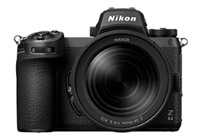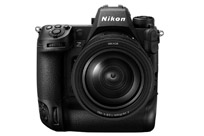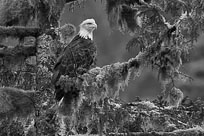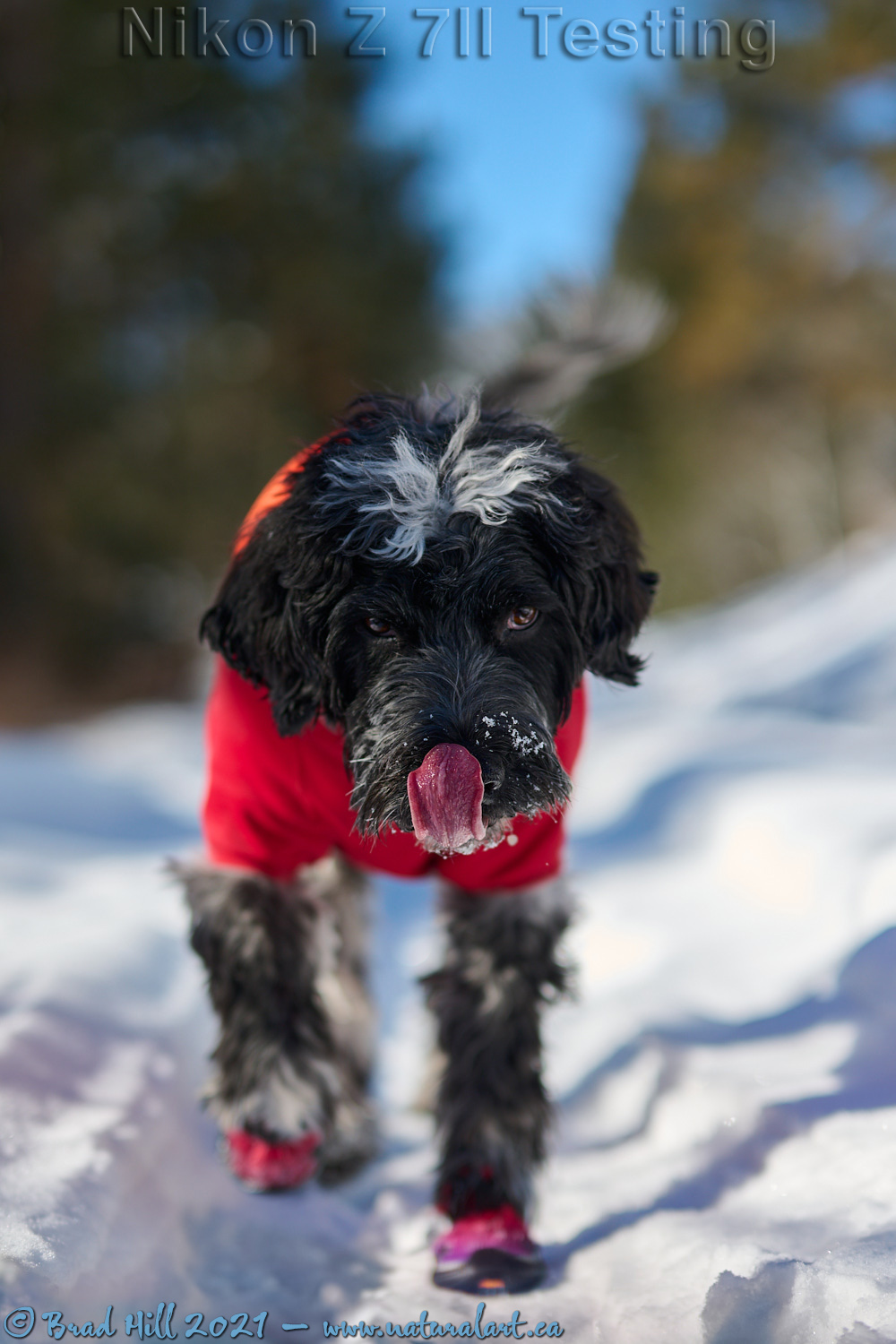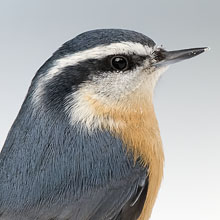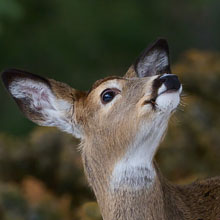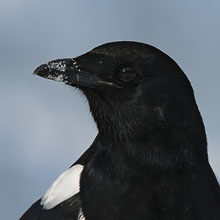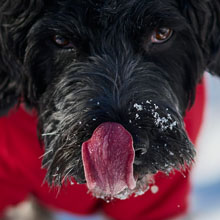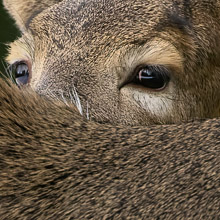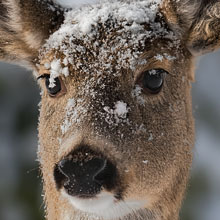Availability: Undetermined - Enquiries?
In the Field
Z 7II Testing - It's NEVER Too Cold to Lick Your Nose. Findlay Creek Region (East Kootenays), British Columbia, Canada. February 12, 2021.
This is another installment on my experiences with shooting using the Nikon Z 7II. In this case Poncho (my increasingly famous Portuguese Water Dog model - and my pandemic "model on demand" wildlife surrogate extraordinaire) is closing in on me and decelerating from a full run while I was shooting a high speed burst of shots with my Z 7II (using the Continuous H Extended mode). And yes, two steps later Poncho had me pinned to the ground and was licking a different nose (mine!).
We could go in three different directions in our discussion about how the Nikon Z 7II performed in this shooting situation - about how it performed in the sub-zero temperatures, about how much I am liking the Z-mount 50mm f1.2S, or about how its autofocus system is working for me. We can deal with the performance in the cold very quickly. This shot was captured at -22C and the camera had been outside at this temperature for a couple hours before I captured this shot (and about 500 more over the next 90 minutes) - so the camera itself was down to ambient temperature. Yes, I was using a battery grip and thus had two batteries in use, but when I returned home I still had 40% charge left on my FIRST battery (with the second still fully charged). And I had NO issues whatsoever with the performance of the camera (the performance of my chilled fingers is another story). Hey, performance in very adverse conditions is ONE reason I shoot Nikon...and so far my Z 7II is stacking up just fine on the "full performance under crappy conditions" scale.
My thoughts on the 50mm f1.2S? That will be the topic of another image post and/or blog entry but here's the short version: Loving it (for both video and stills).
OK...now the MUCH bigger issue - how the Z 7II's AF system is performing for me. I'm primarily a wildlife photographer. Within that genre of photography I particularly enjoy the challenge of shooting the elusive "animalscape". I also opportunistically shoot landscapes, but I would never categorize myself as a landscape photographer. As a wildlife shooter I do shoot "action" shots whenever the opportunity arises, and these action shots include the usual mix of subject matter - birds in flight, swimming bears, sparring grizzlies, wildlife chases (e.g., a male grizzly chasing off a competing male), running or moving canids like wolves and coyotes, and a lot of marine mammal action shots (breaching whales, jumping dolphins, sea lions doing a bunch of crazy things, etc.).
Back in the "before times" I used high-end Nikon DSLR's for shooting my action shots, and the most recent models I've used for my action shooting include the D500, D850, D5, and now D6. The area modes I have found that work the best for me when shooting action shots are either one of the smaller-to-mid-sized Dynamic Area modes (e.g. 25-point or 49-point on the D6) or, even more commonly, Group Area mode. If a moving animal has a strong "toward me" or "away from me" component to its motion, I personally find that I have the highest success rate if I use a Group Area mode (and with the D6 I have 17 Group Area patterns to choose from). Note that even though I have had "the best of the best" tracking modes of any DSLR available (i.e., that of the Nikon D6), I personally don't like using 3D-Tracking for shooting action and I certainly don't get the kind of hit rates I do with Group Area modes. So...my preferred modus operandi for shooting action is to use either a Dynamic Area mode or, more commonly, a Group Area mode and pan with the subject rather than holding the camera fixed in position and rely on tracking to follow my subject across my frame. I am fine with others having different preferences - I am describing only what works best for ME and what I prefer.
Fast-forward to Nikon's mirrorless Z series of cameras. Cue the boisterous online spec spewer who will now LOVE to tell me "Ahah...you're hooped because the Z cameras have NO Group Area modes...you can now die a miserable death or switch brands." True, you can look high and low on any of Nikon's Z cameras and you won't find a Group Area mode. However, those who actually shoot and really field test the cameras will know that the Nikon Z's have Wide-area AF (S) and Wide-area AF (L), and the most recent models (the Z 6II and the Z 7II) also add animal or human eye detection to the Wide-area AF (L) mode. And...if you experiment with the Wide-area modes you'll find they perform pretty much just as the Group Area modes of the Nikon DSLR's. Which means they work great in low contrast situations that "stall" other AF area modes AND they prioritize focus on the closest object (or part of an object) within the area they cover. And, almost invariably, if an animal is moving toward you, the thing you want in focus is the leading edge of that animal.
So...how is the Nikon Z 7II working for me for shooting action, especially subjects that are moving toward or away from me? Well...not as well as a Nikon D5 or D6. No surprise there. BUT, when I use one of the Wide-area AF modes I get really high hit rates with the Z 7II (and they are MUCH higher than I obtained when shooting the original Z7, even after its key firmware updates). How high? In the 80%+ range both using my wildlife surrogate (Poncho) and real wildlife. And, I find the lock-on speed (i.e., speed of initial acquisition of focus) of the Wide-area modes to be very fast too. MOST of the time my preferred Wide-area AF mode to be the S (or small) mode, though the critical determinant is the proportion of the frame your subject fills and at times the Wide-area AF (L) mode may be the better choice.
Could the AF of the Z 7II be improved? Yep. I'd like to see wider-area Dynamic Area modes than its current single Dynamic Area mode and we'd all like to see faster initial acquisition of focus (try to think of a camera you wouldn't want this on). Of course, it would be great if we could get to an "action shot" keeper rate approaching that of the D6 (so in the 95%+ range). Interestingly, the day of writing this commentary (17 Feb 2021) nikonrumors.com has reported that a firmware update for the Nikon Z 6II and Nikon Z 7II will be announced on Feb 18, and that improved AF will be part of the firmware update. Ironically, the LEAST important area of improvement of AF capability of the Z 7II to me (i.e., improved tracking ability) is the most important one of "the internet"! ;-)
Here's a larger version (4800 pixel) of Poncho performing some essential nose sanitation:
• It's NEVER Too Cold to Lick Your Nose: Download 4800 pixel image (JPEG: 2.8 MB)
ADDITIONAL NOTES:
1. This image - in all resolutions - is protected by copyright. I'm fine with personal uses of them (including use as desktop backgrounds or screensavers on your own computer), but unauthorized commercial use of the image is prohibited by law. Thanks in advance for respecting my copyright!
2. Like all photographs on this website, this image was captured following the strict ethical guidelines described in The Wildlife FIRST! Principles of Photographer Conduct. I encourage all wildlife photographers to always put the welfare of their subjects above the value of their photographs.
Behind the Camera
Z 7II Testing - It's NEVER Too Cold to Lick Your Nose. Findlay Creek Region (East Kootenays), British Columbia, Canada. February 12, 2021.
Digital Capture; Compressed RAW (NEF) 14-bit format; ISO 64.
Nikon Z 7II paired with Nikkor 50mm f1.2S. Hand-held. VR on and in Sport mode. Wide-area AF (S) AF mode.
1/5000s @ f1.4; no compensation from matrix-metered exposure setting.
At the Computer
Z 7II Testing - It's NEVER Too Cold to Lick Your Nose. Findlay Creek Region (East Kootenays), British Columbia, Canada. February 12, 2021.
RAW Conversion to 16-bit PSD file (and JPEG files for web use), including all global and selective adjustments, using Phase One's Capture One Pro 21. Global adjustments limited to a tweak to highlight retrieval. Selective local adjustments performed using Capture One Pro's layers and masking tools. In this case selective adjustments were made on 7 separate layers and included one or more tweaks to highlights, blacks, clarity, and color (using both the color editor and color balance tools).
Photoshop modifications were limited to the insertion of the watermark and/or text.
Conservation
Z 7II Testing - It's NEVER Too Cold to Lick Your Nose. Findlay Creek Region (East Kootenays), British Columbia, Canada. February 12, 2021.
Species Status in Canada*: This species is not designated as at risk.
*as determined by ME!







